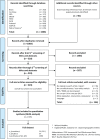Mind the Gap! A Multilevel Analysis of Factors Related to Variation in Published Cost-Effectiveness Estimates within and between Countries
- PMID: 25878194
- PMCID: PMC4708620
- DOI: 10.1177/0272989X15579173
Mind the Gap! A Multilevel Analysis of Factors Related to Variation in Published Cost-Effectiveness Estimates within and between Countries
Abstract
Background: Published cost-effectiveness estimates can vary considerably, both within and between countries. Despite extensive discussion, little is known empirically about factors relating to these variations.
Objectives: To use multilevel statistical modeling to integrate cost-effectiveness estimates from published economic evaluations to investigate potential causes of variation.
Methods: Cost-effectiveness studies of statins for cardiovascular disease prevention were identified by systematic review. Estimates of incremental costs and effects were extracted from reported base case, sensitivity, and subgroup analyses, with estimates grouped in studies and in countries. Three bivariate models were developed: a cross-classified model to accommodate data from multinational studies, a hierarchical model with multinational data allocated to a single category at country level, and a hierarchical model excluding multinational data. Covariates at different levels were drawn from a long list of factors suggested in the literature.
Results: We found 67 studies reporting 2094 cost-effectiveness estimates relating to 23 countries (6 studies reporting for more than 1 country). Data and study-level covariates included patient characteristics, intervention and comparator cost, and some study methods (e.g., discount rates and time horizon). After adjusting for these factors, the proportion of variation attributable to countries was negligible in the cross-classified model but moderate in the hierarchical models (14%-19% of total variance). Country-level variables that improved the fit of the hierarchical models included measures of income and health care finance, health care resources, and population risks.
Conclusions: Our analysis suggested that variability in published cost-effectiveness estimates is related more to differences in study methods than to differences in national context. Multinational studies were associated with much lower country-level variation than single-country studies. These findings are for a single clinical question and may be atypical.
Keywords: cardiovascular disease; economic evaluation; exchangeability; multilevel statistical modeling; statins; transferability.
© The Author(s) 2015.
Conflict of interest statement
The authors declare that they have no conflict of interests, including any financial, personal, or other relationship with other people or organizations within 3 years of beginning this study.
Figures




References
-
- Anderson R. Systematic reviews of economic evaluations: utility or futility. Health Econ. 2010;19(3):350–64. - PubMed
-
- Higgins JPT, Green S, eds. Cochrane Handbook for Systematic Reviews of Interventions. Version 5.1.0 (updated March 2011). The Cochrane Collaboration, 2011. Available from: URL: www.cochrane-handbook.org.
-
- Brunetti M, Shemilt I, Pregno S, et al. GRADE guidelines: 10. Considering resource use and rating the quality of economic evidence. J Clin Epidemiol. 2013;66(2):140–50. - PubMed
-
- Anderson R, Shemilt I. Chapter 3: the role of economic perspectives and evidence in systematic review. In: Shemilt I, Mugford M, Vale L, Marsh K, Donaldson C, eds. Evidence-Based Decisions and Economics: Health Care, Social Welfare, Education and Criminal Justice. Oxford, UK: Wiley-Blackwell; 2010.
MeSH terms
Substances
LinkOut - more resources
Full Text Sources
Miscellaneous

